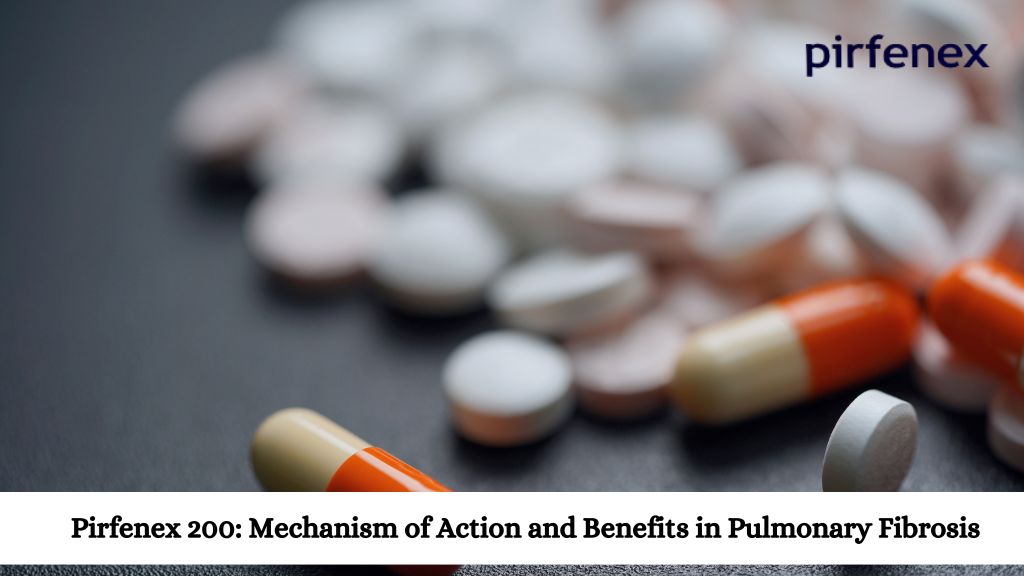
Pulmonary fibrosis is a chronic lung condition characterized by the scarring and thickening of lung tissue. It can result in significant breathing difficulties and reduced lung function. Pirfenex 200, also known as pirfenidone, is a medication commonly used in the treatment of pulmonary fibrosis. In this article, we will explore the mechanism of action of Pirfenex 200 and its benefits in managing pulmonary fibrosis.
Pirfenex 200 is an oral medication that belongs to a class of drugs known as anti-fibrotics. It contains the active ingredient pirfenidone, which is specifically designed to target the fibrotic processes occurring in pulmonary fibrosis. Pirfenex 200 has been approved by regulatory authorities for the treatment of idiopathic pulmonary fibrosis (IPF), a common form of the disease.
1. Anti-inflammatory properties of Pirfenex 200
Pirfenex 200 exhibits anti-inflammatory effects, which play a crucial role in managing pulmonary fibrosis. Inflammation is a key driver of fibrotic processes in the lungs. By reducing inflammation, Pirfenidone 200 helps to control the progression of fibrosis and preserve lung function.
2. Inhibition of fibrosis progression
One of the primary mechanisms of action of Pirfenex 200 is its ability to inhibit the progression of fibrosis. It targets various molecular pathways involved in the fibrotic process, including the production of pro-fibrotic cytokines and the activation of fibroblasts. By interfering with these pathways, Pirfenex 200 helps to prevent the excessive accumulation of scar tissue in the lungs.
Pirfenidone 200 offers several benefits in the management of pulmonary fibrosis:
Slows down disease progression: By targeting the underlying mechanisms of fibrosis, Pirfenex 200 can slow down the progression of pulmonary fibrosis, preserving lung function and improving quality of life.
Reduces symptoms: Patients taking Pirfenex 200 often experience a reduction in symptoms such as cough, shortness of breath, and fatigue. This improvement in symptoms can significantly enhance daily functioning and overall well-being.
Improves exercise tolerance: Pulmonary fibrosis can limit physical activity due to decreased lung capacity. Pirfenex 200 has been shown to improve exercise tolerance, allowing patients to engage in more physical activities and maintain a healthier lifestyle.
Enhances survival rates: Clinical studies have demonstrated that treatment with Pirfenex 200 can lead to increased survival rates in patients with pulmonary fibrosis. Early intervention with Pirfenex 200 is crucial in improving long-term outcomes.
The dosage of Pirfenex 200 may vary depending on individual factors and the severity of the disease. It is typically administered orally, with the recommended starting dose of 801 mg (three capsules) per day. The dosage may be adjusted by the healthcare provider based on the patient’s response and tolerability.
While Pirfenex 200 is generally well-tolerated, it may cause some side effects in certain individuals. Common side effects include gastrointestinal symptoms such as nausea, diarrhea, and loss of appetite. Other less common side effects may include skin rash, photosensitivity, and liver function abnormalities. It is important to discuss any concerns or side effects with a healthcare professional.
Before starting Pirfenex 200, it is essential to inform your healthcare provider about any existing medical conditions, medications, or allergies. Pirfenex 200 may interact with certain medications, and its use may need to be adjusted accordingly. Additionally, women who are pregnant or planning to become pregnant should discuss the potential risks and benefits of Pirfenex 200 with their healthcare provider.
Pirfenex 200, with its mechanism of action targeting inflammation and fibrosis progression, offers valuable benefits in the management of pulmonary fibrosis. By slowing down the disease progression, reducing symptoms, improving exercise tolerance, and enhancing survival rates, Pirfenex 200 plays a significant role in improving the quality of life for individuals living with this condition. It is important to consult with a healthcare provider to determine the suitability and optimal dosage of Pirfenidone 200 for individual cases.
WhatsApp us